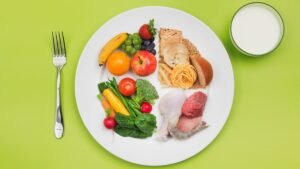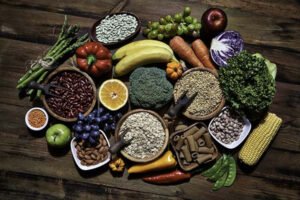
How to Lose Belly Fat
Losing belly fat can be a frustrating and challenging task, but with the right strategies and mindset, it is possible.Struggling with stubborn belly fat? You’re not alone! Belly fat is often the hardest to lose and can be detrimental to your health. Fortunately, with the right strategies, you can achieve a flatter, healthier midsection.
Explore effective ways to lose belly fat, including diet tips, exercises, and lifestyle changes that are easy to incorporate into your daily routine. Say goodbye to that stubborn belly fat and hello to a slimmer, more confident you!
Table of Contents
How to Lose a Belly Fat
1. Eat a balanced diet

A balanced diet is a crucial component of losing belly fat. To lose weight, you need to create a calorie deficit by burning more calories than you consume. However, it’s important to note that not all calories are created equal. A diet that focuses on nutrient-dense foods will not only help you lose weight but also provide essential nutrients for overall health.
Incorporating lean protein sources into your meals is vital for weight loss. Protein helps to increase feelings of fullness and satisfaction, which can reduce overall calorie intake. Chicken, turkey, fish, eggs, tofu, and legumes are excellent sources of lean protein. They provide essential amino acids necessary for muscle repair and growth, which can boost your metabolism and aid in weight loss.
Whole grains are another important component of a balanced diet. They are rich in fiber, which aids in digestion, promotes satiety, and helps regulate blood sugar levels. Brown rice, quinoa, oats, and whole-wheat bread are examples of whole grains that can be incorporated into your meals.
Fruits and vegetables are low in calories and high in essential vitamins, minerals, and fiber. They provide a wide range of nutrients while adding volume to your meals, helping you feel satisfied with fewer calories. Berries, apples, oranges, spinach, kale, and broccoli are nutrient-rich options that can be included in your daily diet.
Including healthy fats in your diet is important for satiety and overall health. Avocado, nuts, seeds, olive oil, and fatty fish like salmon are rich in monounsaturated and polyunsaturated fats, which have been shown to have numerous health benefits. These fats help promote feelings of fullness and can help reduce cravings for unhealthy foods.
It is also important to avoid processed and high-calorie foods as they can contribute to weight gain and increase the risk of health problems. Fast food, sugary drinks, and baked goods are often high in unhealthy fats, added sugars, and refined carbohydrates, which can lead to weight gain and belly fat accumulation.
By adopting a balanced diet that includes lean protein, whole grains, fruits, vegetables, and healthy fats while avoiding processed and high-calorie foods, you can create a calorie deficit and effectively lose belly fat.
2. Incorporate Fiber-Rich Foods

Including fiber-rich foods in your diet can be beneficial for losing belly fat. High-fiber foods not only help you feel fuller for longer but also contribute to overall weight loss and improved digestion.
Fiber adds bulk to your meals, which can help reduce calorie intake by promoting satiety. It also slows down the digestion and absorption of nutrients, preventing spikes in blood sugar levels and helping to regulate appetite.
Here’s a table listing the key components of a balanced diet and their benefits for belly fat loss:
| Component | Examples | Benefits for Belly Fat Loss |
|---|---|---|
| Protein | Lean meats, fish, beans, eggs | Builds muscle, increases metabolism, promotes satiety |
| Healthy Fats | Avocado, olive oil, nuts, seeds | Supports hormone function, reduces cravings, provides long-lasting energy |
| Complex Carbohydrates | Whole grains, vegetables, fruits | Provides sustained energy, improves digestion, prevents fat storage |
| Fiber | Whole grains, fruits, vegetables | Promotes satiety, aids digestion, regulates blood sugar |
| Water | Water, herbal teas | Hydrates, supports metabolism, helps reduce bloating |
| Vitamins and Minerals | Leafy greens, berries, nuts | Supports overall health, boosts metabolism, aids in fat burning |
Some excellent sources of dietary fiber include whole grains, fruits, vegetables, legumes, and nuts. Incorporate foods like brown rice, quinoa, oats, berries, apples, oranges, spinach, kale, lentils, and almonds into your meals and snacks.
Switching to a low-carb diet helped me lose 20 pounds in three months and stabilized my blood sugar levels.” – John Doe, Client
By including fiber-rich foods in your diet, you can support weight loss efforts, improve digestive health, and potentially reduce belly fat.
3. Consider Intermittent Fasting

Intermittent fasting is a dietary strategy that involves alternating periods of fasting and eating. It has gained popularity for its potential to promote weight loss, reduce belly fat, and improve metabolic health.
There are different types of intermittent fasting, but two common methods are the 16/8 method and the 5:2 method. The 16/8 method involves fasting for 16 hours and restricting your eating window to 8 hours each day. During the fasting period, you consume only calorie-free beverages like water or unsweetened tea or coffee. The 5:2 method involves eating normally for five days of the week and restricting calorie intake to 500-600 calories for two non-consecutive days.
Intermittent fasting can be effective for weight loss as it helps reduce overall calorie intake and promotes fat burning. Additionally, it may have beneficial effects on insulin sensitivity and hormone regulation, which can contribute to belly fat reduction.
However, it’s important to note that intermittent fasting may not be suitable for everyone. It’s crucial to listen to your body and consult with a healthcare professional before starting any fasting regimen, especially if you have underlying health conditions or are taking medication.
4. Follow Low Calorie Diet

A low-calorie diet is a dietary approach focused on reducing calorie intake to promote weight loss. It involves consuming fewer calories than your body needs to maintain its current weight, creating a calorie deficit that leads to the burning of stored fat for energy.
Here’s a sample meal plan for the DASH diet, showing the daily intake of fruits, vegetables, grains, and protein:
| Meal | Foods | Serving Size | Category |
|---|---|---|---|
| Breakfast | Oatmeal with berries and almonds | 1 cup oatmeal, 1/2 cup berries, 1 tbsp almonds | Grains, Fruits, Protein |
| Low-fat yogurt | 1 cup | Protein | |
| Morning Snack | Apple slices with peanut butter | 1 medium apple, 1 tbsp peanut butter | Fruits, Protein |
| Lunch | Grilled chicken salad with mixed greens and vegetables | 3 oz chicken, 2 cups mixed greens, 1 cup assorted vegetables | Protein, Vegetables |
| Whole grain roll | 1 roll | Grains | |
| Afternoon Snack | Carrot sticks with hummus | 1 cup carrot sticks, 2 tbsp hummus | Vegetables, Protein |
| Dinner | Baked salmon with quinoa and steamed broccoli | 3 oz salmon, 1 cup quinoa, 1 cup broccoli | Protein, Grains, Vegetables |
| Mixed fruit salad | 1 cup | Fruits | |
| Evening Snack | Low-fat cottage cheese with pineapple chunks | 1/2 cup cottage cheese, 1/2 cup pineapple chunks | Protein, Fruits |
Daily Summary:
- Fruits: 4 servings
- Vegetables: 4 servings
- Grains: 3 servings
- Protein: 5 servings
This table provides a clear and balanced example of a daily meal plan following the DASH diet principles.
The principle behind a low-calorie diet is straightforward: when you consistently consume fewer calories than your body requires, it starts tapping into its fat stores to meet its energy needs. By doing so, you can gradually lose weight and reduce body fat percentage.
The specific calorie intake for a low-calorie diet varies depending on factors such as age, gender, activity level, and weight loss goals. In general, it involves consuming anywhere from 1,200 to 1,500 calories per day, although some individuals may require even lower calorie levels under medical supervision.
To follow a low-calorie diet effectively, it’s important to make every calorie count in terms of nutritional value. Choosing nutrient-dense foods that provide essential vitamins, minerals, and macronutrients is crucial to support overall health and well-being.
A typical low-calorie diet includes plenty of fruits and vegetables, lean protein sources, whole grains, and low-fat dairy products. These foods are generally low in calories while offering a range of essential nutrients. By focusing on these nutrient-rich options, you can ensure that your body receives the necessary fuel without excessive caloric intake.
Portion control is also a key aspect of a low-calorie diet. Even healthy foods can contribute to weight gain if consumed in large quantities. Measuring portions, using smaller plates, and being mindful of portion sizes can help you stay within your calorie limits.
While a low-calorie diet can be effective for weight loss, it’s important to approach it with caution and under the guidance of a healthcare professional or registered dietitian. Severely restricting calories can lead to nutrient deficiencies, fatigue, and potential health risks. Therefore, it’s essential to ensure that you’re still meeting your nutritional needs and maintaining a balanced diet.
“Excess belly fat is linked to an increased risk of heart disease, type 2 diabetes, and certain cancers.”
Therefore, a low-calorie diet is a strategy that involves consuming fewer calories than your body needs to create a calorie deficit and promote weight loss. By focusing on nutrient-dense foods, practicing portion control, and seeking professional guidance, you can utilize a low-calorie diet as part of a comprehensive approach to healthy weight management. Remember, it’s crucial to prioritize overall nutrition and well-being while following any dietary plan.
5. Practice Portion Control

While focusing on eating a balanced diet is important, it’s also crucial to practice portion control. Even healthy foods can contribute to weight gain if consumed in excessive amounts.
To manage portion sizes, you can:
- Use smaller plates and bowls to create the illusion of a fuller plate.
- Be mindful of recommended serving sizes and measure or weigh your food if needed.
- Avoid eating straight from the package, as it can lead to mindless overeating. Instead, portion out an appropriate serving size onto a plate or bowl.
- Pay attention to your body’s hunger and fullness cues. Eat slowly and listen to your body’s signals to determine when you are satisfied.
- By practicing portion control, you can maintain a calorie deficit and support belly fat reduction.
6. Exercise regularly

In addition to a balanced diet, regular exercise is another important factor in losing belly fat. Exercise not only burns calories but also helps build muscle, which can increase your metabolism and aid in weight loss.
Aim for at least 150 minutes of moderate-intensity exercise per week, such as brisk walking, cycling, swimming, or dancing. These activities elevate your heart rate and help burn calories. Cardiovascular exercises are effective for overall fat loss, including belly fat.
Note: There might be affiliate links mentioned here. We may receive a commission if you purchase a product through an affiliate link. There is no additional charge for you. Please do your own research before making any online purchases.
7. Cardiovascular Exercises

- In addition to regular exercise, including cardiovascular exercises in your fitness routine can help you burn calories, shed belly fat, and improve your overall health. Cardio exercises elevate your heart rate and increase your metabolism, leading to increased calorie burning.
- Engaging in activities such as brisk walking, jogging, cycling, swimming, dancing, or using cardio machines like the treadmill or elliptical trainer can be effective for reducing belly fat. Aim for at least 150 minutes of moderate-intensity cardiovascular exercise per week, or 75 minutes of vigorous-intensity exercise if you’re able.
- Mixing up your cardio workouts can help prevent boredom and keep you motivated. Consider trying different activities or participating in group classes to add variety to your routine and make it more enjoyable.
8. Strength Training and Core Exercises

- While cardiovascular exercises are important for overall weight loss, incorporating strength training and core exercises into your routine can help strengthen your muscles, improve your posture, and tone your abdominal muscles.
- Strength training exercises, such as weightlifting, resistance band workouts, or bodyweight exercises like push-ups, squats, and lunges, can help increase muscle mass and boost your metabolism. With more muscle, your body becomes more efficient at burning calories, even at rest.
- Targeting your core muscles through exercises like planks, crunches, and Russian twists can help tone and strengthen your abdominal muscles, giving you a firmer and more defined midsection.
- Including strength training and core exercises in your fitness regimen alongside cardiovascular activities can help maximize your belly fat loss and promote a toned and sculpted appearance.
By combining regular cardiovascular exercise and strength training, you can maximize calorie burn, build lean muscle mass, and ultimately reduce belly fat.
9. Stay Consistent and Patient

Losing belly fat and achieving weight loss goals takes time, consistency, and patience. It’s important to remember that sustainable weight loss is a gradual process and not an overnight transformation.
Avoid falling for quick-fix diets or extreme measures that promise rapid results. These approaches are often unsustainable and can be detrimental to your overall health.
Instead, focus on making long-term lifestyle changes that you can maintain over time. Embrace a balanced and nutritious diet, engage in regular physical activity, manage stress, prioritize sleep, and stay hydrated.
Celebrate small victories along the way and keep track of your progress. Remember that weight loss is not solely about the numbers on the scale but also about improving your overall health and well-being.
If you encounter setbacks or challenges, don’t get discouraged. Learn from them, reassess your approach if necessary, and keep moving forward. Seek support from friends, family, or professionals who can provide guidance and encouragement throughout your journey.
10. Reduce stress

Stress can have a significant impact on weight gain and belly fat accumulation. When you are stressed, your body releases cortisol, a stress hormone that promotes fat storage, particularly in the abdominal area.
Reducing stress levels is important for overall health and can help with belly fat reduction. There are several effective strategies you can incorporate into your daily routine to manage stress and promote relaxation.
Deep breathing exercises can help activate the body’s relaxation response and reduce stress. Taking slow, deep breaths and focusing on your breath can help calm the mind and body. Incorporate deep breathing exercises into your daily routine, such as taking a few minutes in the morning or evening to sit quietly and breathe deeply.
Meditation and yoga are practices that have been shown to reduce stress and promote relaxation. Engaging in these activities regularly can help calm the mind, improve mental well-being, and reduce cortisol levels. You can join a local yoga class or use guided meditation apps or videos to incorporate these practices into your routine.
Engaging in hobbies and activities you enjoy can also be effective in managing stress. Find activities that bring you joy and make time for them regularly. Whether it’s painting, gardening, playing a musical instrument, or reading, engaging in activities that you love can help distract your mind from stressors and promote relaxation.
Spending time with friends and family and Pets is also beneficial for reducing stress. Social support and meaningful connections can help alleviate stress and improve overall well-being. Make time for social activities and prioritize nurturing relationships with loved ones.
Practicing mindfulness is another effective strategy for stress management. Mindfulness involves paying attention to the present moment without judgment. It can be practiced during daily activities such as eating, walking, or even washing dishes. By being fully present in the moment and focusing on your senses, you can reduce stress and improve overall well-being.
By incorporating stress management techniques into your daily routine, you can reduce the production of cortisol, lower stress levels, and potentially reduce belly fat accumulation.
11. Get Enough Sleep

Sleep is often overlooked but is crucial for weight loss and overall health. Lack of sleep can disrupt your metabolism, increase your appetite, and make you crave high-calorie foods.
Aim for 7-9 hours of quality sleep per night to support weight loss efforts. Establishing a regular sleep routine by going to bed and waking up at the same time every day can help regulate your body’s internal clock and improve sleep quality.
Creating a conducive sleep environment is also important. Ensure your bedroom is dark, quiet, and at a comfortable temperature. Avoid electronic devices before bedtime as the blue light emitted can interfere with sleep. Instead, engage in relaxing activities such as reading a book, taking a warm bath, or practicing relaxation techniques to prepare your body for sleep.
By prioritizing sleep and ensuring you get adequate rest, you can support your weight loss goals and reduce the risk of weight gain and belly fat accumulation.
12. Drink plenty of water

Drinking enough water is not only essential for overall health but can also aid in weight loss and reduce belly fat. Water helps to keep you hydrated, supports digestion, and can help suppress your appetite.
Aim for at least 8 glasses of water per day, or more if you are physically active or live in a hot climate. Drinking water before meals can help you feel fuller, leading to reduced calorie intake. Additionally, staying hydrated can help boost your metabolism, allowing your body to burn calories more efficiently.
Replacing sugary drinks such as soda and juice with water is crucial for weight loss. These beverages are often high in calories and added sugars, which can contribute to weight gain and belly fat accumulation. Opt for water as your primary beverage and flavor it with slices of fruits or herbs for added taste if desired.
By staying hydrated and prioritizing water as your beverage of choice, you can support your weight loss journey and reduce belly fat.
13. Avoid alcohol

Alcohol consumption is linked to weight gain and belly fat accumulation. Alcoholic beverages are high in calories and can disrupt your metabolism, leading to increased fat storage, particularly in the abdominal area.
If you choose to drink alcohol, it is important to do so in moderation. Limit your alcohol intake and opt for lower-calorie options such as wine or light beer. Be mindful of the calories consumed from alcohol and consider the impact it may have on your weight loss efforts.
14. Non-Surgical Methods for Belly Fat Loss and Weight Loss

In addition to the lifestyle changes mentioned above, there are several non-surgical methods that can aid in fat and weight loss. These methods are generally safe and effective when used under the guidance of healthcare professionals. Here are some popular non-surgical approaches:
a) CoolSculpting: CoolSculpting, also known as cryolipolysis, is a non-invasive fat reduction procedure that uses controlled cooling to freeze and eliminate stubborn fat cells. It is commonly used to target specific areas such as the abdomen, thighs, and love handles. The frozen fat cells are naturally eliminated by the body over time, resulting in a more sculpted appearance.
b) Laser lipolysis: Laser lipolysis, or laser-assisted liposuction, is a minimally invasive procedure that uses laser energy to liquefy and remove fat cells. It can be performed on various body areas and is particularly effective for targeting small, localized fat deposits. The procedure also stimulates collagen production, resulting in tighter and firmer skin.
c) Radiofrequency treatments: Radiofrequency treatments use radiofrequency energy to heat the deeper layers of the skin, stimulating collagen production and tightening loose skin. These treatments can help improve the appearance of cellulite and sagging skin in areas such as the abdomen, thighs, and arms.
d) Ultrasound therapy: Ultrasound therapy utilizes high-intensity focused ultrasound (HIFU) energy to target and destroy fat cells without harming the surrounding tissues. This non-invasive procedure can be used to reduce fat in areas such as the abdomen, flanks, and thighs. It also stimulates collagen production, leading to skin tightening effects.
e) Injection-based treatments: Injection-based treatments, such as lipotropic injections or mesotherapy, involve the injection of certain substances into the targeted areas to facilitate fat breakdown and metabolism. These injections often contain a combination of vitamins, amino acids, and enzymes that help enhance fat burning and promote weight loss.
f) Non-surgical gastric balloons: Non-surgical gastric balloons are temporary devices placed in the stomach to create a feeling of fullness and promote portion control. They are inserted through an endoscopic procedure and can remain in the stomach for several months. The presence of the balloon helps individuals consume smaller meals and reduce calorie intake, resulting in weight loss.
g) Non-surgical body contouring treatments: Non-surgical body contouring treatments, such as high-intensity focused electromagnetic (HIFEM) technology or radiofrequency devices, can help tone and sculpt the body by stimulating muscle contractions and improving muscle definition.
These treatments are particularly beneficial for individuals looking to enhance muscle tone and reduce stubborn fat in areas like the abdomen and buttocks.
It’s important to note that these non-surgical methods are not meant to replace a healthy diet and exercise. They are generally intended for individuals who have already made lifestyle changes but are struggling with stubborn fat deposits or need additional support to reach their goals. Consulting with a qualified healthcare professional is essential to determine if these treatments are suitable for your specific needs and to ensure their safe and effective implementation.
Remember, sustainable weight loss and fat reduction requires a holistic approach that includes a balanced diet, regular exercise, and healthy lifestyle habits. Non-surgical methods can complement these efforts but should be seen as adjunctive tools rather than standalone solutions.
Therefore, non-surgical methods such as CoolSculpting, laser lipolysis, radiofrequency treatments, ultrasound therapy, injection-based treatments, non-surgical gastric balloons, and non-surgical body contouring treatments can provide additional support for fat and weight loss. However, it’s crucial to consult with healthcare professionals and maintain a healthy lifestyle to achieve long-term results.
Conclusion
In conclusion, losing belly fat requires a multifaceted approach that includes a balanced diet, regular exercise, stress management, adequate sleep, hydration, and potentially intermittent fasting. It’s important to remember that weight loss and belly fat reduction take time and may not happen overnight. Set realistic goals, stay consistent, and be patient with your progress.
It’s also crucial to listen to your body and make adjustments as needed. Everyone’s body is different, and what works for one person may not work for another. Focus on finding the strategies and lifestyle changes that work best for you, and make sustainable changes that you can maintain in the long run.
Remember, it’s always beneficial to seek support from a healthcare professional or a registered dietitian who can provide personalized guidance and support throughout your weight loss journey. With dedication, perseverance, and the right strategies, you can successfully lose belly fat, improve your health, and enhance your overall well-being.
Disclaimer: The information provided in this article is for educational purposes only and should not be considered as a substitute for medical advice. Consult a healthcare professional before implementing any home remedies or making significant changes to your lifestyle.
FAQs
What are the best foods to eat to lose belly fat?
Foods high in fiber, lean proteins, and healthy fats, such as fruits, vegetables, nuts, seeds, and fish, can help reduce belly fat.
Which exercises are most effective for targeting belly fat?
Exercises like cardio, strength training, and specific core workouts (e.g., planks, crunches) can effectively target and reduce belly fat.
How does stress contribute to belly fat?
Chronic stress can lead to increased cortisol levels, which can promote fat storage around the abdomen.
Can drinking water help in losing belly fat?
Yes, staying hydrated can boost metabolism, help control appetite, and aid in digestion, contributing to overall fat loss including belly fat.
What lifestyle changes can help reduce belly fat?
Incorporating regular exercise, a balanced diet, proper sleep, and stress management can significantly help reduce belly fat.







